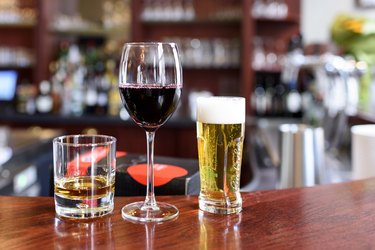
The calories in alcohol can seriously add up, and even light-to-moderate drinking can derail your weight loss goals.
Though some alcoholic beverages may be called "light," all alcohol contains calories. Unfortunately, you cannot avoid calories if you want to enjoy an alcoholic drink. You can, however, decrease your caloric intake by choosing drinks that contain fewer calories and by cutting back on drinking altogether.
Video of the Day
Video of the Day
Is There Such a Thing as Zero-Calorie Alcohol?
The three main groups of alcoholic beverages — distilled spirits, wine and beer — are made up of various levels of alcohol, water and most of the time, carbohydrates.
Water contains no calories, but carbohydrates and alcohol, respectively, contain 4 and 7 calories per gram, as outlined by the University of California. So, no, there's no such thing as zero-calorie alcohol.
Related Reading
Standard Sizes and Calories in Alcoholic Drinks
What's considered a "standard drink" in the U.S. is one that contains about 14 grams, or 98 calories, of alcohol, according to Rethinking Drinking, a website by the National Institute of Alcohol Abuse and Alcoholism.
Broken down, the standard drink is equivalent to:
- 1.5 ounces of 80-proof distilled spirits
- 5 ounces of wine
- 12 ounces of regular beer
The caloric difference in these drinks comes from their carbohydrate content. Here's a breakdown of calories and carbohydrates in some of the most popular alcoholic beverages.
Liquor
The lowest-calorie alcohol is plain liquor — with no mixers, unless you're using a zero-calorie one. 1.5-ounce shot of liquor has under 100 calories and 0 grams of carbohydrates. Most distilled alcohol is more potent than light beer or wine.
Distilled beverages, such as vodka, gin and rum, are labeled by proof, which is the alcohol content, doubled. For example, a 40 proof bottle of distilled liquor is 20 percent alcohol. The higher the proof, the more potent the liquor, per Rethinking Drinking.
When you're sipping a cocktail or mixed drink, your beverage will increase in both calories and carbs. While 1.5 ounces of tequila contains 97 calories and 0 grams of carbohydrates, per the USDA, a single tequila sunrise (a cocktail made of tequila, orange juice and grenadine syrup) contains 252 calories, 30 grams of carbohydrates and 22 grams of sugar.
Wine
A 5-ounce glass of red wine contains 125 calories and 3.8 grams of carbohydrates, per the USDA.
White wine is about 12 percent alcohol and red wine is about 14 percent alcohol. To make white wine even lower in calories, you can dilute it with sparkling water. The resulting white wine spritzer not only has fewer calories but also has a lower alcohol content.
You'll want to avoid using sparkling water with added flavors as it can unpleasantly affect the flavor of the wine.
Light Beer
The nutritional profile of beer will greatly vary depending on the brand and its alcohol by volume (ABV) content.
Some brands offer a light beer alternative that contains fewer than 100 calories per 12-ounce serving, while others go a bit higher, between 120 and 130 calories in a 12-ounce serving, per the Center for Science in the Public Interest (CSPI).
For comparison, a typical 12-ounce can of beer contains 155 calories and 13 grams of carbohydrates, per the USDA, but again, it really depends. A Budweiser, for example, contains 145 calories with a 5 percent ABV while a Samuel Adams Rebel IPA contains 198 calories with a 6.5 percent ABV.
This can make light beer attractive as a lower-calorie choice. It's important to note, however, that light beer is also lighter in alcohol content, at around 3 percent, while regular beer has between 3 to 8 percent alcohol.
Related Reading